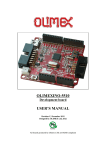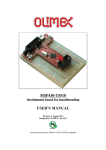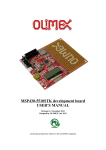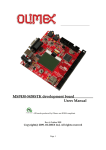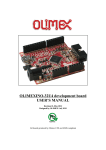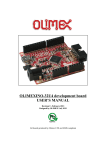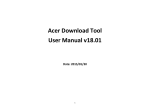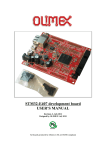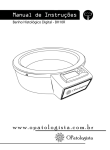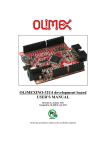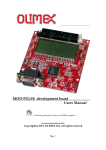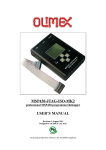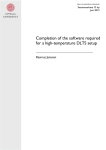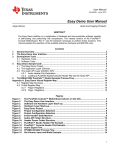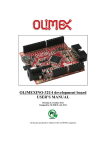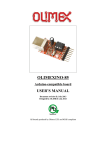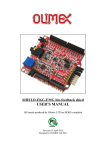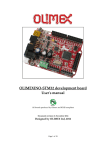Download OLIMEXINO-5510 USER`S MANUAL
Transcript
OLIMEXINO-5510 Development board USER’S MANUAL Document revision D, July 2015 Designed by OLIMEX Ltd, 2012 All boards produced by Olimex LTD are ROHS compliant OLIMEX© 2015 OLIMEXINO-5510 user's manual DISCLAIMER © 2015 Olimex Ltd. Olimex®, logo and combinations thereof, are registered trademarks of Olimex Ltd. Other product names may be trademarks of others and the rights belong to their respective owners. The information in this document is provided in connection with Olimex products. No license, express or implied or otherwise, to any intellectual property right is granted by this document or in connection with the sale of Olimex products. It is possible that the pictures in this manual differ from the latest revision of the board. The Hardware project is released under the Creative Commons Attribution-Share Alike 3.0 United States License. You may reproduce it for both your own personal use, and for commertial use. You will have to provide a link to the original creator of the project http://www.olimex.com on any documentation or website. You may also modify the files, but you must then release them as well under the same terms. Credit can be attributed through a link to the creator website: http://www.olimex.com. The software is released under GPL. The product described in this document is subject to continuous development and improvements. All particulars of the product and its use contained in this document are given by OLIMEX in good faith. However all warranties implied or expressed including but not limited to implied warranties of merchantability or fitness for purpose are excluded. This document is intended only to assist the reader in the use of the product. OLIMEX Ltd. shall not be liable for any loss or damage arising from the use of any information in this document or any error or omission in such information or any incorrect use of the product. This evaluation board/kit is intended for use for engineering development, demonstration, or evaluation purposes only and is not considered by OLIMEX to be a finished end-product fit for general consumer use. Persons handling the product must have electronics training and observe good engineering practice standards. As such, the goods being provided are not intended to be complete in terms of required design-, marketing-, and/or manufacturing-related protective considerations, including product safety and environmental measures typically found in end products that incorporate such semiconductor components or circuit boards. Olimex currently deals with a variety of customers for products, and therefore our arrangement with the user is not exclusive. Olimex assumes no liability for applications assistance, customer product design, software performance, or infringement of patents or services described herein. THERE IS NO WARRANTY FOR THE DESIGN MATERIALS AND THE COMPONENTS USED TO CREATE OLIMEXINO-5510. THEY ARE CONSIDERED SUITABLE ONLY OLIMEXINO-5510. Page 2 of 28 OLIMEX© 2015 OLIMEXINO-5510 user's manual Table of Contents DISCLAIMER............................................................................................................. 2 CHAPTER 1: OVERVIEW........................................................................................5 1. Introduction to the chapter....................................................................................................5 1.1 Features..................................................................................................................................5 1.2 Target market and purpose of the board............................................................................6 1.3 Organization..........................................................................................................................6 CHAPTER 2: SETTING UP THE OLIMEXINO-5510 BOARD...........................7 2. Introduction to the chapter....................................................................................................7 2.1 Electrostatic warning............................................................................................................7 2.2 Hardware requirements....................................................................................................... 7 2.3 Powering the board and operating modes..........................................................................8 2.4 Prebuilt software and bootloader........................................................................................8 2.5 EasyMSP and Energia..........................................................................................................9 CHAPTER 3: OLIMEXINO-5510 BOARD DESCRIPTION...............................10 3. Introduction to the chapter..................................................................................................10 3.1 Layout (top view)................................................................................................................ 10 3.2 Layout (bottom view)..........................................................................................................11 CHAPTER 4: THE MSP430F5510 MICROCONTROLLER.............................. 12 4. Introduction to the chapter..................................................................................................12 4.1 The microcontroller............................................................................................................ 12 CHAPTER 5: CONTROL CIRCUITY................................................................... 14 5. Introduction to the chapter..................................................................................................14 5.1 Reset..................................................................................................................................... 14 5.2 Clocks...................................................................................................................................14 5.3 Power supply circuit........................................................................................................... 14 CHAPTER 6: CONNECTORS AND PINOUT......................................................15 6. Introduction to the chapter..................................................................................................15 6.1 SBW (Spy-Bi-Wire) debug connector............................................................................... 15 6.2 UEXT connector..................................................................................................................16 6.3 Arduino shield platform connectors..................................................................................17 6.4 MINI USB............................................................................................................................18 6.5 Battery connector................................................................................................................18 6.6 Jumper description............................................................................................................. 19 6.6.1 P_OUT/P_IN.................................................................................................................19 6.6.2 3.3V_E........................................................................................................................... 19 6.6.3 AGND_E........................................................................................................................19 6.6.4 CHG_D..........................................................................................................................19 6.6.5 AREF_E........................................................................................................................ 19 6.6.6 TI_TST/OLI_TST and TI_RST/OLI_RST................................................................19 Page 3 of 28 OLIMEX© 2015 OLIMEXINO-5510 user's manual 6.6.7 HW_SCL/SW_SCL and HW_SDA/SW_SDA........................................................... 20 6.7 Additional hardware components......................................................................................20 CHAPTER 7: BLOCK DIAGRAM AND MEMORY........................................... 21 7. Introduction to the chapter..................................................................................................21 7.1 Processor block diagram.................................................................................................... 21 7.2 Physical memory map.........................................................................................................22 CHAPTER 8: SCHEMATICS..................................................................................23 8. Introduction to the chapter..................................................................................................23 8.1 Eagle schematic................................................................................................................... 23 8.2 Physical dimensions............................................................................................................ 25 CHAPTER 9: REVISION HISTORY AND SUPPORT........................................ 26 9. Introduction to the chapter..................................................................................................26 9.1 Document revision...............................................................................................................26 9.2 Board revision..................................................................................................................... 26 9.3 Useful web links and purchase codes................................................................................ 27 9.4 Product support...................................................................................................................28 Page 4 of 28 OLIMEX© 2015 OLIMEXINO-5510 user's manual CHAPTER 1: OVERVIEW 1. Introduction to the chapter Thank you for choosing the OLIMEXINO-5510 development board from Olimex! This document provides a user’s guide for the Olimex OLIMEXINO-5510 board. As an overview, this chapter gives the scope of this document and lists the board’s features. The document’s organization is then detailed. The OLIMEXINO-5510 development board enables code development of applications running on the microcontroller MSP430F5510, manufactured by Texas Instruments. 1.1 Features Some of the main board features are listed below: MCU: MSP430F5510 with 32K Bytes Program Flash, 4K Bytes RAM, 25Mhz Power supply circuit Power-on led Li-Po battery connector Li-Po battery recharge circuit RTC (Real-time clock) quartz crystal UEXT connector User LED SBW interface User button, boot button and RESET button Reset button FR-4, 1.5 mm, soldermask, component print Dimensions: 53.3mm x 55.9mm (2.1'' x 2.2") Page 5 of 28 OLIMEX© 2015 OLIMEXINO-5510 user's manual 1.2 Target market and purpose of the board OLIMEXINO-5510 is intended to work with Energia - an Arduino-like IDE for MSP430. The community is working on adding full support for Energia. At the time of writing this manual such support isn't fully added but it is on the way. When such support is implemented there will be software examples below in Energia format. OLIMEXINO-5510 was specially designed for the EasyMSP project which is created by Matthew Burmeister (a.k.a. MattTheGeek from 43oh.com). Matt did amazing work by creating Arduino-like language and commands to compile with MSP430 hardware just adding these in header files, so they compile with MSPGCC. However, personal problems restrained Matthew to finish the project he started. That is why Energia is the now default and recommended development environment. The target market are the MSP430 fans and electronics beginners. People with better understanding of software than hardware. Arduino platform fans. 1.3 Organization Each section in this document covers a separate topic, organized as follow: – Chapter 1 is an overview of the board usage and features – Chapter 2 provides a guide for quickly setting up the board and software notes – Chapter 3 contains the general board diagram and layout – Chapter 4 describes the component that is the heart of the board: the OLIMEXINO-5510 microcontroller – Chapter 5 is an explanation of the control circuitry associated with the microcontroller to reset. Also shows the clocks on the board – Chapter 6 covers the connector pinout, peripherals and jumper description – Chapter 7 shows the memory map – Chapter 8 provides the schematics – Chapter 9 contains the revision history, useful links and support information Page 6 of 28 OLIMEX© 2015 OLIMEXINO-5510 user's manual CHAPTER 2: SETTING UP THE OLIMEXINO-5510 BOARD 2. Introduction to the chapter This section helps you set up the OLIMEXINO-5510 development board for the first time. Please consider first the electrostatic warning to avoid damaging the board, then discover the hardware and software required to operate the board. The procedure to power up the board is given, and a description of the default board behavior is detailed. 2.1 Electrostatic warning OLIMEXINO-5510 is shipped in a protective anti-static package. The board must not be exposed to high electrostatic potentials. A grounding strap or similar protective device should be worn when handling the board. Avoid touching the component pins or any other metallic element. 2.2 Hardware requirements In order to set up the OLIMEXINO-5510 optimally, the following items are required: 1) mini USB cable for uploading a binary using the bootloader 2) JTAG/SBW (Spy-Bi-Wire) MSP430 compatible programmer – for custom programming We offer three low-cost products capable of programming the board (of course any JTAG/SBWcompatible programmer you might already own would do the job): MSP430-JTAG-ISO-MK2 – our best MSP430 programmer, featuring LCD display, SD card and stand-alone mode of programming: https://www.olimex.com/Products/MSP430/JTAG/MSP430JTAG-ISO-MK2/ MSP430-JTAG-TINY-V2 – standalone programmer: https://www.olimex.com/Products/MSP430/JTAG/MSP430-JTAG-TINY-V2/ Notice our MSP programmers work with a free flash software we distribute and are compatible with all IDEs based on the original Texas Instruments MSP430.dll. Additional components and extension boards (not required for basic operation!): - 3.7V lithium-polymer battery You gain mobility and back-up. The battery can be recharged when plugged to OLIMEXINO-5510 because of the built-in charger circuit (which also has the option to be disconnected via jumper). Page 7 of 28 OLIMEX© 2015 OLIMEXINO-5510 user's manual Our offer is: https://www.olimex.com/Products/Power/BATTERY-LIPO1400mAh/. - Shields Some of the shields we sell for our Arduino boards can be found here: https://www.olimex.com/Products/Duino/Shields/ - UEXT expansion boards All OLIMEX boards which names start with MOD, are compatible with the UEXT interface. Notice that there is multiplexing between the Arduino platform connector (for the shields) and the UEXT. You can't use two devices with SPI communication at the same time. 2.3 Powering the board and operating modes The board is powered either via the mini USB or via the 3.7V_LI_BAT connector or via the SBW interface. The board can be programmed in three ways: 1) as a general purpose board via the SBW. 2) by the BSL (BootStrap Loader) bootloder by MSP430 When powered the red power LED should turn on. By default the green LED near the battery connector should start blinking if used in debugger/general mode. To enter BSL mode hold USB_BSL and power the board. Or while the board is powered hold USB_BSL down then press RESET and then release USB_BSL. If the board is started in BSL mode the green LED should remain off. 2.4 Prebuilt software and bootloader The prebuilt software is a bootloader and a simple LEDs and buttons test. When you power the board initially all LEDs will be on. If you press and hold the B1 button LED2 should start blinking. If you press and hold WAKE_UP button LED1 should start blinking. Upon releasing the buttons the LEDs should return to their initial “always on” state. Note that you can compile binaries (suitable to upload via the bootloader) using various software products. People typically use Code Composer Studio; IAR Embedded Workbench for MSP430; Rowley CrossWorks for MSP430. Page 8 of 28 OLIMEX© 2015 OLIMEXINO-5510 user's manual 2.5 EasyMSP and Energia OLIMEXINO-5510 is intended to work with Energia - an Arduino-like IDE for MSP430. The community is working on adding full support for Energia. At the time of writing this manual such support isn't fully added but it is on the way. When such support is implemented there will be software examples below in Energia format. The Energia web site and repository may be found at the following web addresses: http://energia.github.com/Energia/ and https://github.com/energia/Energia/ OLIMEXINO-5510 was specially designed for the EasyMSP project which is created by Matthew Burmeister (a.k.a. MattTheGeek from 43oh.com). Matt did amazing work by creating Arduino-like language and commands to compile with MSP430 hardware just adding these in header files, so they compile with MSPGCC. However, personal problems restrained Matthew to finish the project he started. That is why Energia is the now default and recommended development environment. EasyMSP community is at 43oh.com forum http://www.43oh.com/forum/viewforum.php?f=34. The project is hosted at http://code.google.com/p/easymsp/. When we learned about EasyMSP the first idea was to create custom open hardware board which to work with EasyMSP. So we contacted Matt and asked him if he wants custom board build for his project. This is how OLIMEXINO-5510 was born. So if you want to develop some hand-held or battery powered devices with USB connection to PC OLIMEXINO-5510 is the low cost solution for you. The software for the boards is released under General Purpose License. Page 9 of 28 OLIMEX© 2015 OLIMEXINO-5510 user's manual CHAPTER 3: OLIMEXINO-5510 BOARD DESCRIPTION 3. Introduction to the chapter Here you get acquainted with the main parts of the board. Note the names used on the board might differ from the names used below to describe them. For the actual names check the OLIMEXINO5510 board itself. 3.1 Layout (top view) Page 10 of 28 OLIMEX© 2015 OLIMEXINO-5510 user's manual 3.2 Layout (bottom view) Page 11 of 28 OLIMEX© 2015 OLIMEXINO-5510 user's manual CHAPTER 4: THE MSP430F5510 MICROCONTROLLER 4. Introduction to the chapter In this chapter is located the information about the heart of OLIMEXINO-5510 – its microcontroller MSP430F5510. The information is a modified version of the datasheet provided by its manufacturers. 4.1 The microcontroller w Supply-Voltage Range, 1.8 V to 3.6 V Ultra-Low Power Consumption - Active Mode (AM) - All System Clocks Active - 195 µA/MHz at 8 MHz, 3 V, Flash Program Execution (Typical) - 115 µA/MHz at 8 MHz, 3 V, RAM Program Execution (Typical) - Standby Mode (LPM3) - Real Time Clock With Crystal, Watchdog, and Supply Supervisor Operational, Full RAM Retention, Fast Wake-Up: 1.9 µA at 2.2 V, 2.1 µA at 3 V (Typical) -Low-Power Oscillator (VLO), General-Purpose Counter, Watchdog, and Supply Supervisor Operational, Full RAM Retention, Fast Wake-Up: 1.4 µA at 3 V (Typical) - Off Mode (LPM4) - Full RAM Retention, Supply Supervisor Operational, Fast Wake-Up: 1.1 µA at 3 V (Typical) - Shutdown Mode (LPM4.5) 0.18 µA at 3 V (Typical) Wake-Up From Standby in Less Than 5 µs 16-Bit RISC Architecture, Extended Memory, Up to 25-MHz System Clock Flexible Power Management System - Fully Integrated LDO With Programmable Regulated Core Supply Voltage - Supply Voltage Supervision, Monitoring, and Brownout Unified Clock System - FLL Control Loop for Frequency Stabilization - Low-Power Low-Frequency Internal Clock Source (VLO) - Low-Frequency Trimmed Internal Reference Source (REFO) - 32-kHz Watch Crystals (XT1) - High-Frequency Crystals up to 32 MHz (XT2) 16-Bit Timer TA0, Timer_A With Five Capture/Compare Registers 16-Bit Timer TA1, Timer_A With Three Capture/Compare Registers 16-Bit Timer TA2, Timer_A With Three Capture/Compare Registers 16-Bit Timer TB0, Timer_B With Seven Capture/Compare Shadow Registers Two Universal Serial Communication Interfaces Page 12 of 28 OLIMEX© 2015 OLIMEXINO-5510 user's manual - USCI_A0 and USCI_A1 Each Supporting: - Enhanced UART Supporting Auto-Baudrate Detection - IrDA Encoder and Decoder - Synchronous SPI - USCI_B0 and USCI_B1 Each Supporting: - I2CTM - Synchronous SPI Full-Speed Universal Serial Bus (USB) Integrated USB-PHY Integrated 3.3-V/1.8-V USB Power System Integrated USB-PLL Eight Input, Eight Output Endpoints 10-Bit Analog-to-Digital (A/D) Converter With Window Comparator Comparator Hardware Multiplier Supporting 32-Bit Operations Serial Onboard Programming, No External Programming Voltage Needed Three Channel Internal DMA Basic Timer With Real Time Clock Feature For comprehensive information on the microcontroller visit the Texas Instruments’ web page for a datasheet. At the moment of writing the microcontroller datasheet can be found at the following link: http://www.ti.com/lit/ds/symlink/msp430f5510.pdf Page 13 of 28 OLIMEX© 2015 OLIMEXINO-5510 user's manual CHAPTER 5: CONTROL CIRCUITY 5. Introduction to the chapter Here you can find information about reset circuit and quartz crystals locations, the power supply circuit is discussed. 5.1 Reset OLIMEXINO-5510's reset circuit includes R7 (33Ω), R8 (330Ω), and a RESET button. 5.2 Clocks Q1 – 32 768 MHz quartz crystal on pins 8 and 9 of the F5510 allowing RTC(Real-Time Clock). Q2 – 4 MHz quartz crystal is connected to pins 45 and 46 of the MSP430F5510 processor. 5.3 Power supply circuit The power supply circuit of OLIMEXINO-5510 allows powering via two sources – from the miniUSB (the device will draw it's required current automatically, however ensure the USB port is standard compatible and can provide at least 1A of current) or from the Li-Po connector if you have 3.7V battery. If you have both connected the USB power will charge the battery (if the battery is not full). Page 14 of 28 OLIMEX© 2015 OLIMEXINO-5510 user's manual CHAPTER 6: CONNECTORS AND PINOUT 6. Introduction to the chapter In this chapter are presented the connectors that can be found on the board all together with their pinout and notes about them. Jumpers functions are described. Notes and info on specific peripherals are presented. Notes regarding the interfaces are given. 6.1 SBW (Spy-Bi-Wire) debug connector The SBW interface is used to program and debug the board. It is also known as “2-wire JTAG”. “NC” stands for “Not Connected”. SBW interface Pin # Signal Name Pin # Signal Name 1 NC/TI_RST* 8 OLI_TST/NC* 2 NC/P_IN** 9 GND 3 NC 10 NC 4 P_OUT/NC* 11 OLI_RST/NC* 5 Not connected 12 NC 6 Not connected 13 NC 7 NC/TI_TST* 14 NC *The information lines can be switched via the SMD jumpers TI_RST/OLI_RST and TI_TST/OLI_TST. This might be required for different programmers. If you use Texas Instruments programmer switch them to TI_RST and TI_STS. If using Olimex programmer switch to OLI_RST and OLI_TST. By default they are in Olimex position. **The Pin/Pout jumper declares if the board is internally powered or has to be powered externally (via SBW programmer). Page 15 of 28 OLIMEX© 2015 OLIMEXINO-5510 user's manual 6.2 UEXT connector OLIMEXINO-5510 board has a UEXT connector and can interface Olimex's UEXT expansion modules. For more information on UEXT please visit: http://www.olimex.com/dev/OTHER/UEXT.pdf UEXT connector Pin # Signal Name 1 +3.3V 2 GND 3 D1(TXD) 4 D0(RXD) 5 SW_SCL/NC* 6 SW_SDA/NC* 7 NC/D12(MISO1)* 8 NC/D11(MOSI1)* 9 D13(SCK) 10 #UEXT_CS *Those pin signals depend on the jumpers HW_SCL/SW_SCL and HW_SDA/SW_SDA. By default the board is set in software SPI mode (SW_SCL/SW_SDA). Notice the orientation of the cut on the connector in the picture above. Page 16 of 28 OLIMEX© 2015 OLIMEXINO-5510 user's manual 6.3 Arduino shield platform connectors The pad names are written on the board and the names are above the corresponding pads. Arduino shield POWER – CON1 Pad name [Name], Processor pin# ANALOG – CON2 Pad name [Name], Processor pin# RST RST, 48 A0 1 3V3 11,28 A1 2 5V 41 A2 3 GND 12, 27, 37 A3 BAT_SENSE, 4 GND 12, 27, 37 A4 AREF, 5 V_IN - A5 6 DIGITAL – CON3 Pad name [Name], Processor pin# DIGITAL – CON4 Pad name [Name], Processor pin# D0 RXD, 34 D8 20 D1 TXD, 33 D9 21 D2 14 D10 #SS, 29 D3 15 D11 MOSI, 30 D4 16 D12 MISO, 31 D5 17 D13 SCK, 32 D6 18 GND 14, 18 D7 19 AREF 5 The ones with the optional [Name] attribute present are multiplexed with another connector or peripheral. In our case the signals are multiplexed with the UEXT. Page 17 of 28 OLIMEX© 2015 OLIMEXINO-5510 user's manual 6.4 Mini USB This connector can be used to program the board (as an alternative to using a programmer tool). Make sure to enter bootloader mode and use the mini USB to establish connection between the board and the personal computer. To enter BSL mode hold USB_BSL and power the board. Or while the board is powered hold USB_BSL down then press RESET and then release USB_BSL. If the board is started in BSL mode the green LED should remain off. There are no drivers required. This is because the MSP430 reports itself as a Human Interface Device (HID), which has built-in Windows support. HID is a great fit for firmware updates. The only way to upload code via the USB at the moment is to use a pack of softawre tools from the official Texas Instruments web-site. The software tool to search for and download is named: “MSP430 USB Firmware Upgrade Example”. Note that you can compile binaries (suitable to upload via the bootloader) using various software products. People typically use Code Composer Studio; IAR Embedded Workbench for MSP430; Rowley CrossWorks for MSP430. Pin # Signal Name 1 +5V 2 D- 3 D+ 4 Not connected 5 GND Note that this is not USB OTG (On-The-Go). 6.5 Battery connector Please make sure you use 3.7V lithium battery. The voltage of such a battery might vary from 2.75V up to 4.2V (discharged, fully charged). Note that the board features battery charging circuit. It will charge the battery if it's voltage drop below a certain threshold and other source of power is present. Mind that such a charging might draw considerable amount of current (especially if the battery is fully discharged). When the board has a battery connected AND USB connected simultaneously the battery would get recharged thanks to the recharge circuit. Pin # Signal Name 1 VBAT 2 GND The pin names are also written on the top of the board in the base of the connector. Page 18 of 28 OLIMEX© 2015 OLIMEXINO-5510 user's manual 6.6 Jumper description Please note that the jumpers on the board are ONLY SMD type. For setting the SMD jumpers please consider that if you feel insecure of your soldering/cutting technique it is better not to try to adjust those jumpers. 6.6.1 P_OUT/P_IN When in position P_IN, the board gets powered by SBW debugger. When is position P_OUT, the board gets powered by other two sources. The default position is P_OUT. 6.6.2 3.3V_E When open 3.3V_E the processor doesn't receive power. Processor pins 11 and 28 are disconnected from the power circuit. The default position is closed. 6.6.3 AGND_E When open AGND_E disables the analog ground signal. The default position is closed. 6.6.4 CHG_D When closed disables the battery charging circuit. The default position is jumper open. 6.6.5 AREF_E When open disables the AREF on the shield CON4. The default position is open. 6.6.6 TI_TST/OLI_TST and TI_RST/OLI_RST Note these jumpers must be moved together! They control the TST and RST signals on the SBW interface. The TST and RST differ when using different programmers. If you are not sure how your programmer is configured and the board doesn't get programmed via SBW try the TI_TST + TI_RST option. The default position is OLI_TST closed + OLI_RST closed. Page 19 of 28 OLIMEX© 2015 OLIMEXINO-5510 user's manual 6.6.7 HW_SCL/SW_SCL and HW_SDA/SW_SDA Note these jumpers must be moved together! They configure either hardware or software SPI on the UEXT. The default position is set for software SPI – SW_SCL closed + SW_SDA closed. 6.7 Additional hardware components The components below are mounted on OLIMEXINO-5510 but are not discussed above. They are listed here for completeness: Reset button – used for hardware reset of the board BUT – general purpose button USB_BSL – used for starting the MSP430 bootstrap loader Battery recharge circuit Battery sense circuit on processor pin 25 LED1 (Green) – pin 26 + Power LED (Red) Page 20 of 28 OLIMEX© 2015 OLIMEXINO-5510 user's manual CHAPTER 7: BLOCK DIAGRAM AND MEMORY 7. Introduction to the chapter On the next page you can find a memory map for this family of processors. It is strongly recommended to refer to the original datasheet released by NXP for one of higher quality. 7.1 Processor block diagram The block diagram is taken from the original datasheet of MSP430F5510. Page 21 of 28 OLIMEX© 2015 OLIMEXINO-5510 user's manual 7.2 Physical memory map This is the memory map diagram from the original datasheet of MSP430F5510. You may use it if you need to adjust the configuration file in Olimex MSP programmer software (to add the device). Page 22 of 28 OLIMEX© 2015 OLIMEXINO-5510 user's manual CHAPTER 8: SCHEMATICS 8. Introduction to the chapter In this chapter you would find the schematics describing logically and physically OLIMEXINO5510. 8.1 Eagle schematic OLIMEXINO-5510's schematics are shown for reference. You can also find them on the web page for OLIMEXINO-5510 at our site: https://www.olimex.com/Products/Duino/MSP430/OLIMEXINO-5510/. They are located in HARDWARE section. The EAGLE schematic is situated on the next page for quicker reference. Page 23 of 28 OLIMEX© 2015 OLIMEXINO-5510 user's manual POWER_SUPPLY +5V 3.3V 3.3V_E R4 0R(Board_Mounted) 0R IRLML 6402 VOUT 1 M CP7381 2T -4 20 I/OT 10uF/6.3V 2 3 VDD VBAT C1 1 BATT ERYCE CHARG ER 1 2 C2 15k GND C4 10uF/6.3V 10uF/6.3V 100nF D 10k R9 R10 NA NA 10uF/6.3V AGND_E - CLOSE 1 1 2 3 4 5 6 +5V G ND2 G ND1 USB G ND4 G ND3 C16 10uF/6.3V +5V USB VBUS DD+ ID GND 100nF R16 R17 DD+ GND 27R 27R R15 U1 C9 100nF 100nF C10 C11 220nF/25V 470nF/16V 11 28 12 27 13 43 7 C13 C14 10uF/6.3V 100nF C17 100nF 1.5k C18 C19 R18 1M/1% 10pF 10pF MINI-USB R19 33k C8 DVCC1 DVCC2 P1_7/TA1_0 P1_6/TA1CLK/CBOUT P1_5/TA0_4 P1_4/TA0_3 P1_3/TA0_2 P1_2/TA0_1 P1_1/TA0_0 P1_0/TA0CLK/ACLK DVSS1 DVSS2 VCORE V18 AVCC1 P2_0/TA1_1 10 44 AVSS1 AVSS2 42 VUSB 41 39 40 38 37 VBUS PUR PU1/DM PU_0/DP VSSU P4_7/PM_NONE P4_6/PM_NONE P4_5/PM_UCA1RXD/PM_UCA1SOMI P4_4/PM_UCA1TXD/PM_UCA1SIMO P4_3/PM_UCB1CLK/PM_UCA1STE P4_2/PM_UCB1SOMI/PM_UCB1SCL P4_1/PM_UCB1SIMO/PM_UCB1SDA P4_0/PM_UCB1STE/PM_UCA1CLK AGND R14 100R D0(RXD) D1(TXD) D2 D3 D4 D5 D6 D7 3.3V L1 USB_BSL T 11 07A-6 _3 .8 _2 .5 C15 F B 0 8 0 5 / 6 0 0 R / 2 0 0 m A (2 0 12 0 9 -6 0 1 ) USB_DEVICE 3.3VA #RST TEST LED1 BAT_SENSE_E UEXT_PWR_E #UEXT_CS 48 47 26 25 24 23 A0 A1 A2 A3 A4 A5 NA CON3 AGND 3.3V RST 3V3 5V GND GND VIN NA CON2 A0 A1 A2 A3 A4 A5 2 U3 1 2 3 4 5 6 3.3V +5V UEXT_PWR_E C5 3.7V-LI_BAT DW02R appr. 70 mA char g e curr ent CON1 #RST R6 C6 1uF/10V 2 CLOSE C3 R3 10k 5 VSS PROG R2 VBAT 1 + 4 R1 2k 3.3V_E 3 3.3V P5_5/XOUT P5_4/XIN P5_3/XT2OUT P5_2/XT2IN P5_1/A9/VEREFP5_0/A8/VEREF+ #RST/NMI/SBWTDIO TEST/SBWTCK PJ_3/TCK PJ_2/TMS PJ_1/TDI/TCLK PJ_0/TDO P6_3/CB3/A3 P6_2/CB2/A2 P6_1/CB1/A1 P6_0/CB0/A0 21 20 19 18 17 16 15 14 D9 D8 D7 D6 D5 D4 D3 D2 22 BUT 36 35 34 33 32 31 30 29 SOFT_SCL SOFT_SDA D0(RXD) D1(TXD) D13(SCK) D12(MISO) D11(MOSI) D10(#SS) 1 2 3 4 5 6 7 8 D0 D1 D2 D3 D4 D5 D6 D7 NA CON4 D8 D9 D10(#SS) D11(MOSI) D12(MISO) D13(SCK) 1 2 3 4 5 6 7 8 POWER FET1 VIN FET2 IRLML6402 A NA LO G U2 G +5V D PWR +5V S 0 6 0 3 (R E D ) Battery Charger R5 100k M CP1700 T -3 302E/M B 2 DIG ITA L D1 1N5819(S4SOD-123) D8 D9 D10 D11 D12 D13 GND AREF DIG ITA L open VR1(3.3V) G S 2 NA 2xPN1x8+2xPN1x6 AGND AREF_E 1 C20 10pF C21 10pF 9 8 46 45 6 5 A5 A4 QCT32768(2x6)/6pF 4 3 2 1 A3 A2 A1 A0 Q2 Q1 GN D C22 39pF C23 39pF ARD U IN O : SH P LA TFO RM CHG_D 1 A4 2 Open Q4.000MHz/20pF C7 R21 330R C24 100nF R8 330R RESET T 11 07A-6_3.8_2 .5 R20 NA LED1 0603(GREEN) R25 2k 3.3V R11 330R R13 1M/1% SBW 1 3 5 7 9 11 13 2 4 6 8 10 12 14 2 BUT TEST 1 3 P_OUT/P_IN P_O UT :Cl ose;P_IN:Open BH14R Page 24 of 28 C12 100nF VBAT R12 470k/1% BAT_SENSE_E SOFT_SDA 2 D1(TXD) D0(RXD) D12(MISO) D11(MOSI) D13(SCK) #UEXT_CS OLIMEXINO-5510_Rev_B Designed by OLIMEX LTD. 2012 http://www.olimex.com/dev/ R23 4.7k 3.3V _E 3.3V _E 3.3V _E 3.3V _E R22 4.7k 2 UEXT-1 UEXT-2 UEXT-3 UEXT-4 UEXT-5 UEXT-6 UEXT-7 UEXT-8 UEXT-9 UEXT-10 BH10R BH10R BH10R BH10R 33k #RST #RST NA (1nF ) T 1 1 0 7 A -6 _ 3 . 8 _ 2. 5 BUT 1 2 3 BH10R BH10R BH10R BH10R BH10R BH10R R 24 T I_T ST :Ope n;O LI_T ST :Cl ose 1 2 3 UEXT 1 T I_ RST :Open;OLI_ RST :Cl ose LED1 R7 33k BATTERY Measure 3 TI_TST/OLI_TST 1 TI_RST/OLI_RST 3 DEBUG INTERFACE: H W _S DA /S W _S DA LEDS 3.3V H W _ S D A : O p e n / S W _ S D A : C lo s e BUTTONS H W _S CL/S W _S CL SOFT_SCL H W _ S C L : O p e n / S W _ S C L : C lo s e MSP430F5510 OLIMEX© 2015 OLIMEXINO-5510 user's manual 8.2 Physical dimensions Note that all dimensions are in mils. The three highest elements on the board with same height are: JTAG/SBW connector – 340mil; UEXT connector – 340mil; Arduino shield connectors – 340mil. Page 25 of 28 OLIMEX© 2015 OLIMEXINO-5510 user's manual CHAPTER 9: REVISION HISTORY AND SUPPORT 9. Introduction to the chapter In this chapter you will find the current and the previous version of the document you are reading. Also the web-page for your device is listed. Be sure to check it after a purchase for the latest available updates and examples. 9.1 Document revision Revision, Date Changes Modified Page# A, 31.07.12 Initial Creation All B, 07.12.12 Link updates Clarification on the 2-wire debug C, 13.12.12 Fixed wrong info about P_OUT/P_IN jumper 20 D, 27.07.15 Added information about drivers and ways of programming Improved document formatting All 9.2 Board revision Revision B Notable Changes Initial release of the board Page 26 of 28 5, 7, 8, 23, 24 OLIMEX© 2015 OLIMEXINO-5510 user's manual 9.3 Useful web links and purchase codes The web page you can visit for more info on your device is https://www.olimex.com/Products/Duino/MSP430/OLIMEXINO-5510/ ORDER CODES: OLIMEXINO-5510 – OLIMEXINO-5510 featuring MSP430F5510 processor MSP430-JTAG-TINY-V2 – low cost fast USB JTAG and SWD tool suitable for programming and flash emulation: https://www.olimex.com/Products/MSP430/JTAG/MSP430-JTAG-TINY-V2/ MSP430-JTAG-ISO-V2 – our best MSP430 programmer, featuring LCD display, SD card and stand-alone mode of programming: https://www.olimex.com/Products/MSP430/JTAG/MSP430JTAG-ISO-MK2/ USB-MINI-CABLE – USB mini to USB-A cable You can order directly from our web shop or by any of our distributors. Please check the list of distributors: https://www.olimex.com/Distributors/. Check our web site https://www.olimex.com/ for more info. Page 27 of 28 OLIMEX© 2015 OLIMEXINO-5510 user's manual 9.4 Product support For product support, hardware information and error reports mail to: [email protected]. All document or hardware feedback is welcome. Note that we are primarily a hardware company and our software support is limited. Please consider reading the paragraph below about the warranty of Olimex products. All goods are checked before they are sent out. In the unlikely event that goods are faulty, they must be returned, to OLIMEX at the address listed on your order invoice. OLIMEX will not accept goods that have clearly been used more than the amount needed to evaluate their functionality. If the goods are found to be in working condition, and the lack of functionality is a result of lack of knowledge on the customers part, no refund will be made, but the goods will be returned to the user at their expense. All returns must be authorized by an RMA Number. Email [email protected] for authorization number before shipping back any merchandise. Please include your name, phone number and order number in your email request. Returns for any unaffected development board, programmer, tools, and cables permitted within 7 days from the date of receipt of merchandise. After such time, all sales are considered final. Returns of incorrect ordered items are allowed subject to a 10% restocking fee. What is unaffected? If you hooked it to power, you affected it. To be clear, this includes items that have been soldered to, or have had their firmware changed. Because of the nature of the products we deal with (prototyping electronic tools) we cannot allow returns of items that have been programmed, powered up, or otherwise changed post shipment from our warehouse. All returned merchandise must be in its original mint and clean condition. Returns on damaged, scratched, programmed, burnt, or otherwise 'played with' merchandise will not be accepted. All returns must include all the factory accessories which come with the item. This includes any In-Circuit-Serial-Programming cables, anti-static packing, boxes, etc. With your return, enclose your PO#. Also include a brief letter of explanation of why the merchandise is being returned and state your request for either a refund or an exchange. Include the authorization number on this letter, and on the outside of the shipping box. Please note: It is your responsibility to ensure that returned goods reach us. Please use a reliable form of shipping. If we do not receive your package we will not be held liable. Shipping and handling charges are not refundable. We are not responsible for any shipping charges of merchandise being returned to us or returning working items to you. The full text might be found at https://www.olimex.com/wiki/GTC#Warranty for future reference. Page 28 of 28




























